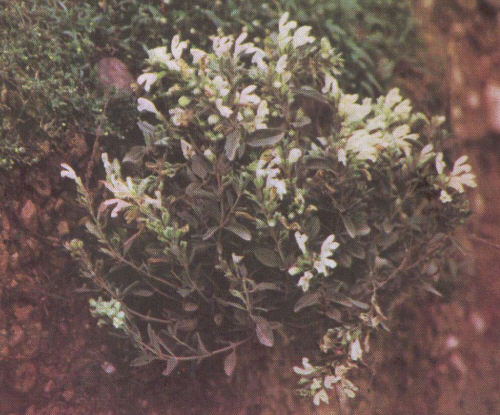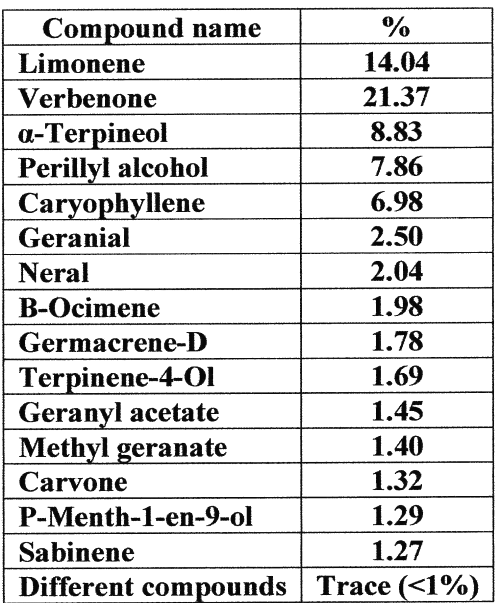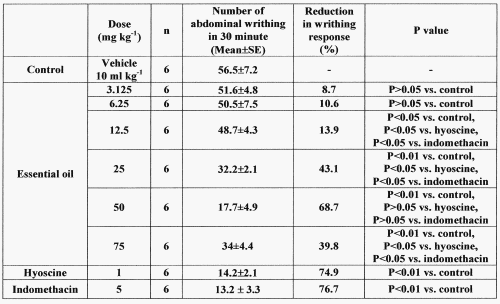J Pharm Pharmaceut Sci (www.ualberta.ca/~csps) 7(1):76-79, 2004
Antinociceptive effects of the essential oil of Dracocephalum kotschyi in the mouse writhing test.
Samira Golshani, Fariba Karamkhani, Hamid Reza Monsef-Esfehani, Mohammad Abdollahi1
Faculty of Pharmacy, and Pharmaceutical Sciences Research Center, Tehran University of Medical Sciences, Tehran, IranReceived 22 December 2003, Revised 17 March 2004, Accepted 17 March 2004, Published 20 April 2004
PDF Version
Abstract
PURPOSE: Dracocephalum kotschyi is a wild-growing flowering plant belonging to the family Labiatae and found abundantly in Iran. This plant has been used in Iran folk medicine as analgesic. METHODS. The Dracocephalum kotschyi essential oil was isolated and studied on writhing test a visceral pain model in mice. Different constituents of the essential oil were determined by gas chromatography mass spectrophotometry technique. RESULTS. Limonene, verbenone, α-terpineol, perillyl alcohol and caryophyllene were the major constituents of the essential oil. The essential oil in doses (mg kg-1) used 12.5 (13.9%, P<0.05), 25 (43.1%, P<0.01), 50 (68.7%, P<0.01), 75 (39.8%, P<0.01) induced significant reduction in pain response when compared to control. The ED50 was 61.61 mg kg -1 . Hyoscine (1 mg kg -1 ) and indomethacin (5 mg kg-1) induced significant (P<0.01) reductions (74.9% and 76.7% respectively) in pain response in comparison to control. CONCLUSION. This study confirms that antinociceptive properties of D. kotschyi are comparable to those of hyoscine and indomethacin used. Presence of limonene and a-terpineol might be responsible for antinociceptive properties of this essential oil. Further studies are necessary to find out a place for it in antispasmodic therapies in human.
Introduction
Since the available analgesic drugs exert a wide range of side effects and are either too potent or too weak, the search for new analgesic compounds has been a priority of pharmacologists and pharmaceutical industries [1]. Medicinal plants are believed to be an important source of new chemical substances with potential therapeutic effects [2, 3]. Thus, study of plant species that traditionally have been used as pain killers should still be seen as a logical research strategy, in search for new analgesic drugs [4].
The D. Kotschyi is a wild-growing flowering plant belonging to the family Labiatae and is found abundantly in southwestern Asia. D. kotschyi have been used as a medicinal herb for several years in Iran folk medicine for its antispasmodic and analgesic properties. Anti-hyperlipidemic [5] and immunomodulatory [6] effects have been reported for D. kotschyi. Our recent study about the essential oil of Teucrium polium another plant from the same family showed significant antinociception when tested by the mouse writhing test [7]. Among the several models of visceral pain, the writhing test has been mostly used as a standard screening method specially when evaluating for antispasmodic properties. This study was designed to explore the composition of Iranian D. kotschyi essential oil and to test its antivisceral pain effects in more detail in mice.
Materials and Methods
Preparation of essential oil
Dracocephalum kotschyi aerial parts were collected during the flowering period from Bojnord (Khorasan, in Northeast of Iran) (Figure 1).
Figure 1: Dracocephalum kotschyi.
They were then pulverized and the volatile fraction was isolated by hydro distillation method. A voucher specimen was authenticated and then deposited in the herbarium of Faculty of Pharmacy, Tehran University of Medical Sciences for future evidence.
Analysis of essential oil
A Thermoquest GC 2000 was interfaced with a quadropole mass spectrometer (Thermo Finnigan Mat). A fused silica capillary column (DB1 30 m Χ 0.32 mm i.d.) was used in the GC analysis with helium as the carrier gas with flow of 1.5 ml min-1. Kovats indices were calculated by using retention times of N-alkanes (C7- C30) that were injected after the essential oil at the same temperature and under the same conditions. Identification of the components of the oil was carried out by comparison of their retention times and MS spectra data with those reported in the literatures.
Animals
Male albino N-MRI mice from animal house of Faculty of Pharmacy, Tehran University of Medical Sciences (TUMS) weighing 20-25 g were kept under standardized conditions (temperature 22±2°C, normal lighting) and fed with the normal laboratory diet. The experimental protocol was approved by the animal care review committee of TUMS.
Preparation of reference and test compounds
Hyoscine (1 mg kg-1) [8] and indomethacin (5 mg kg-1) [9] were used as reference drugs for comparison.
The essential oil was suspended in a solution of carboxymethylcelulose, tween 80, and normal saline (0.5:3.03:96.97 w/v/v). The doses of 3.125, 6.25, 12.5, 25, 50, 75, 100, and 400 mg/kg of essential oil were used.
All treatments were done intraperitoneally (ip), 30 min before the administration of 0.6% acetic acid (15 mg/kg). Respective controls received only the suspension as vehicle.
Writhing test
Mice were ip administered with the test preparations. After 30 minutes, each animal was ip administered with acetic acid 0.6% (15 ml/kg) and individually housed in a glass cylinder on a flat glass floor and a mirror was arranged at an angle of 45 degrees under the cylinder.
Antinociception was recorded by counting the number of writhes after injection of acetic acid during 30 minutes. A writhe is indicated by abdominal constriction and stretching of at least one hind limb [10, 11].
Statistical analysis
Comparison between groups was made by one-way analysis of variance (ANOVA) followed by Tukey's multiple comparison test. Differences with P<0.05 and lower between experimental groups were considered statistically significant. ED50 was determined by probit analysis method using computer and SPSS statistical software.
Results
The percentage yields of essential oil based on the dried plant was 0.2% (v: w). Composition of essential oil has been summarized in table 1.
Table 1: Main constituents from essential oil determined by GC-MS.
Limonene, verbenone, á-terpineol, perillyl alcohol and caryophyllene are the major constituents of the essential oil. Antinociceptive effects induced by different doses of essential oil on the writhing test in mice are shown in table 2.
Table 2: Effect of Dracocephalum kotschyi essential oil on mouse writhing test.
n= number of animals per group. Inhibition percent was obtained in comparison to control. The ED50 for antinociceptive effect was 61.62 mg kg-1. The essential oil was suspended in a solution of carboxymethylcelulose, tween 80, water (0.5: 3.03: 96.97 w v-1 v-2). Control animals received this suspension as vehicle. Hyoscine and indomethacin were dissolved in saline. All treatments were done by intraperitoneal injection 30 minutes before intraperitoneal administration of acetic acid 0.6% (15 mg kg-1). Antinociception was recorded by counting the number of writhes after injection of acetic acid during 30 minutes. A writhe is indicated by abdominal constriction and stretching of at least one hind limb. There was no significant difference in number of abdominal writhing in 30 minute between saline- and vehicle-treated groups.
The essential oil in doses (mg/kg) used 12.5 (13.9%, P<0.05), 25 (43.1%, P<0.01), 50 (68.7%, P<0.01), 75 (39.8%, P<0.01) induced with ED50 of 61.61 mg kg-1. Hyoscine (1 mg kg-1) and indomethacin (5 mg kg-1) induced significant (P<0.01) reductions (74.9% and 76.7% respectively) in pain response in comparison to control.
No significant difference was observed in animals treated by dose of 3.125 and 6.25 mg/kg of essential oil when compared to control.
Discussion
The variability in climate and geographic conditions in Iran provides a rich source of vegetation, comprising many species of plants. Among these plants, D. Kotschyi belonging to the family Labiatae has been widely used for its antispasmodic and analgesic effects in Iran folk medicine [12]. Previous studies on hydroalcoholic extract and polyphenolic fraction of D. kotschyi showed their ability to lower the serum levels of cholesterol and triglycerides in hyperlipidemic rats [5]. D. kotschyi has been also shown to modulate immune system of animals by inhibiting lymphocytes [6]. Contrary to its antispasmodic use in Iran folk medicine as mentioned above, there is no pharmacological report about antinociceptive properties of this herb in bibliography. Our recent study about essential oil of the Teucrium polium another wild-growing flowering plant of Iran belonging to the same family ( Labiatae ) showed very good antinociceptive effects in mouse writhing test with E50 of 29.41 mg kg-1[7]. Regarding the traditional use of D. kotschyi as antispasmodic, we selected the mouse writhing test, which is known as a visceral pain model nociception [10, 11]. Several mediators such as kinin, acetylcholine, substance P, calcitonin-gene-related peptide and prostaglandins take part in visceral pain model nociception [10] and transmission of nociception from the viscera [11]. No interaction of the present essential oil or its components with those mediators has been reported. As shown in table 1, limonene, verbenone, á-terpineol, perillyl alcohol and caryophyllene were the major constituents of the present essential oil. Among major constituents of the present essential oil, anti-inflammatory effect has been only reported for limonene and terpineol [13]. The limonene has been tested in the lipopolysaccharide (LPS)-induced pleurisy model and assayed for immunoregulatory activity by measurement of the inhibition of nitric oxide and production of the cytokines, gamma-interferon and IL-4. The pure limonene when administered orally was able to inhibit the LPS-induced inflammation including cell migration and inhibiting the production of nitric oxide, gamma-interferon and IL-4 [14]. The terpineol is a volatile terpenoid alcohol with low toxicity that is widely used in the perfumery industry. The inhibitory effect of terpineol on the compound action potential of rat sciatic nerve has been reported [15]. Thus the antinociceptive effect of the D. kotschyi is partly due to the presence of limonene and terpineol in its essential oil but the exact mechanism of action remains to be elucidated. However, this study confirms the antivisceral pain properties of D. Kotschyi are comparable to those of hyoscine and indomethacin and suggests a good place for it in antispasmodic and antinociceptive therapies in human.
References
Mattison N, Trimple AG, Lasagna I. New drug development in the United States, 1963 through 1984. Clin Pharmacol Ther 1998, 43:290-301.
Farnsworth NR. Screening plants for new medicines. In: Wilson EO, editor, Biodiversity, part II, National Academy Press, Washington 1989: pp 83-97.
Blumenthal M. Herbal medicines. Integrative Medicine Communications, Austin 2000: pp 419-423.
Rang HP, Dale MM, Ritter JM. Pharmacology. Churchill Livingston, New York 1998: pp 614-616.
Ebrahim Sajjadi S, Movahedian Atar AM, Yektaian A. Antihyperlipidemic effect of hydroalcoholic extract, and polyphenolic fraction from Dracocephalum kotschyi Boiss. Pharm Acta Helv 1998, 73:167-70.
Amirghofran Z, Azadbakht M, Karimi MH. Evaluation of the immunomodulatory effects of five herbal plants. J Ethnopharmacol 2000, 72:167-72.
Abdollahi M, Karimpour H, Monsef-Esfehani HR. Antinociceptive effects of Teucrium polium L total extract and essential oil in mouse writhing test. Pharmacol Res 2003, 48:31-5.
Goel JL, Singh H, Kohll MS, Ahluwalia KS. Effect of concurrent use of BDZs and anticholinergics on the safety index of ether and halothane in mice. Int J Pharmac 1987, 10: 221-225.
Kozak W, Archuleta I, Mayfield K.P., Kozak A., Rudolph K., Kluger M.J. Inhibitors of alternative pathways of arachidonate metabolism differentially affect fever in mice. Am J Physiol 1998, Abstract 5: 0252- R.
Vogel HG, Vogel WH. Drug discovery and evaluation, Pharmacological assays. Springer- Verlag, Berlin Heidelberg, 1997.
Cervero F, Larid JM. Visceral pain. Lancet 1999, 353: 2145-2148.
Zargari A. 1990. Medicinal Plants. 4th ed. Tehran University Publications, Tehran, 1990, pp. 42–45.
Duke JA, Beckstrom SM. Handbook of Medicinal Mints, Phytochemicals and Biological Activities. CRC Press, Florida, 1996.
Souza MC, Siani AC, Ramos MF, Menezes-de-Lima OJ, Henriques MG. Evaluation of anti-inflammatory activity of essential oils from two Asteraceae species. Pharmazie 2003, 58:582-6.
Moreira MR, Cruz GM, Lopes MS, Albuquerque AA, Leal-Cardoso JH. Effects of terpineol on the compound action potential of the rat sciatic nerve. Braz J Med Biol Res 2001, 34:1337-40.Corresponding Author: Mohammad Abdollahi, Department of Toxicology & Pharmacology, Faculty of Pharmacy, and Laboratory of Toxicology, Pharmaceutical Sciences Research Center, Tehran University of Medical Sciences, Tehran 14155-6451, Iran. mohammad.abdollahi@utoronto.caPublished by the Canadian Society for Pharmaceutical Sciences.
Copyright © 1998 by the Canadian Society for Pharmaceutical Sciences.
http://www.ualberta.ca/~csps



